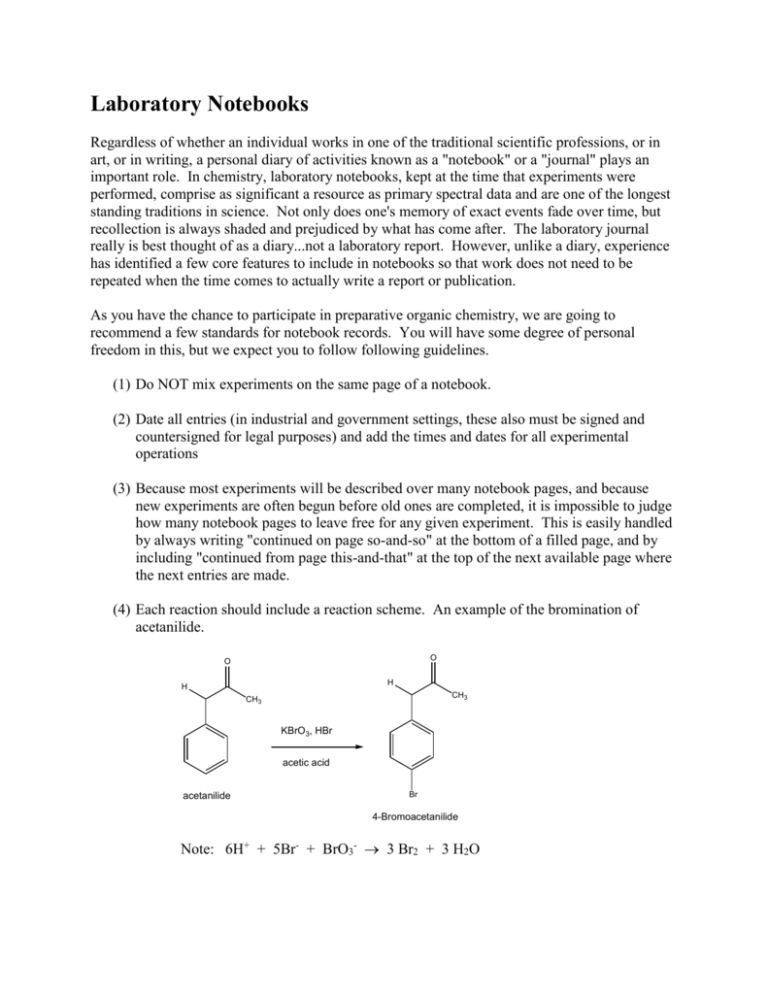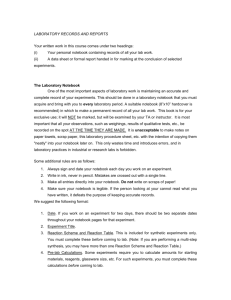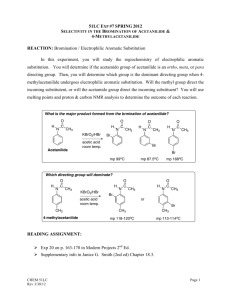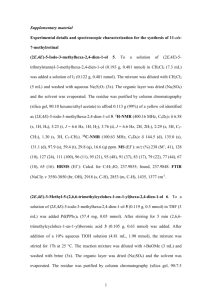Laboratory Notebooks
advertisement

Laboratory Notebooks Regardless of whether an individual works in one of the traditional scientific professions, or in art, or in writing, a personal diary of activities known as a "notebook" or a "journal" plays an important role. In chemistry, laboratory notebooks, kept at the time that experiments were performed, comprise as significant a resource as primary spectral data and are one of the longest standing traditions in science. Not only does one's memory of exact events fade over time, but recollection is always shaded and prejudiced by what has come after. The laboratory journal really is best thought of as a diary...not a laboratory report. However, unlike a diary, experience has identified a few core features to include in notebooks so that work does not need to be repeated when the time comes to actually write a report or publication. As you have the chance to participate in preparative organic chemistry, we are going to recommend a few standards for notebook records. You will have some degree of personal freedom in this, but we expect you to follow following guidelines. (1) Do NOT mix experiments on the same page of a notebook. (2) Date all entries (in industrial and government settings, these also must be signed and countersigned for legal purposes) and add the times and dates for all experimental operations (3) Because most experiments will be described over many notebook pages, and because new experiments are often begun before old ones are completed, it is impossible to judge how many notebook pages to leave free for any given experiment. This is easily handled by always writing "continued on page so-and-so" at the bottom of a filled page, and by including "continued from page this-and-that" at the top of the next available page where the next entries are made. (4) Each reaction should include a reaction scheme. An example of the bromination of acetanilide. O O H H CH3 CH3 KBrO3, HBr acetic acid acetanilide Br 4-Bromoacetanilide Note: 6H+ + 5Br- + BrO3- 3 Br2 + 3 H2O (5) Each reaction should include a table like the one below. The table should be filled in as completely as possible before you come to lab and completed as much as possible in lab: An example of a table prepared before lab: Name Acetanilide Molecular formula Molecular weight (g/mol) Density (g/mL) Concentration Vol/weight used Moles used 0.200 g 1.5 mmol solid Origin (Aldrich, etc.) Physical characteristics (color, etc.) mp/bp Rf (solvent) UV/Vis IR NMR Hydrobromic Acetic acid acid HBr C2H4O2 4-Bromoacetanilide C8H9NO Potassium bromate KBrO3 135.17 167.01 80.92 60.05 214.07 3.270 1.049 Glacial (99.99+%) 0.085 g 0.5 mmol 1.490 48% (weight percent in water) 0.3 mL 2.6 mmol Solid liquid Liquid lachtrymator mp 113-115 2 mL 3.5 x10-5 =0.035 mmol C8H9NOBr 1.5 mmol (100% yield) mp 170-171 Nujol mull NH 3294 sp2 CH C=O 1664 (90 MHz in CDCl3) NH (1H) 7.79ppm broad Ortho (2H) 7.49 ppm Meta (2H) 7.30 ppm Para (1H) 7.10 ppm CH3 (3H) 2.138 ppm All data from experiemental from Schatz, P. F. J. Chem. Ed. 1996, 73, 267, the Aldrich catalog or SDBS website. (6) You should write in your intended procedure before you come to lab. Leave room to fill in all of the observations that you will make while in lab. This includes (but is not limited to): TLC record of solvents, labeled spots and plate sketches, eluent and development method, colors, times, etc.; color, odor, and other significant features observed for the materials; reaction times and color changes; reaction work up procedures, etc. (7) Descriptive notes, conclusions, speculations, and/or suggestions (8) A yield and percent yield (9) Any references for data or procedures.











